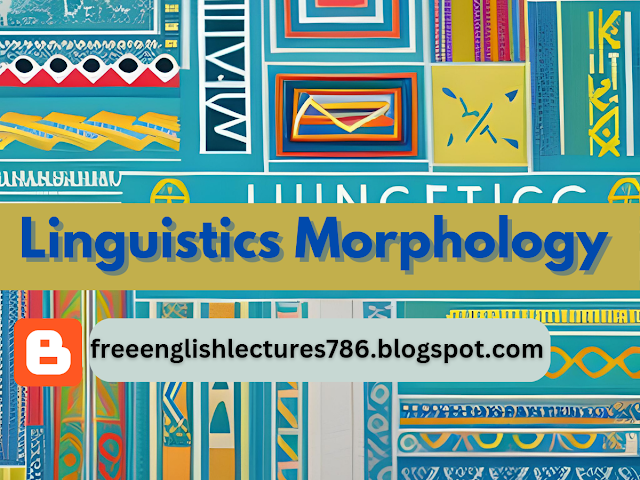Linguistics Morphology
 |
| Linguistics Morphology |
Table of Contents
1. Introduction
Language is a complex system that allows us to communicate and express our thoughts, emotions, and ideas. One of the fascinating aspects of language is its structure, particularly the formation and arrangement of words. Linguistics morphology delves into the study of the internal structure of words and the rules governing their formation. In this article, we will explore the fascinating field of linguistics morphology, uncovering the secrets behind the building blocks of words.
2. What is Linguistics Morphology?
Linguistics morphology is a subfield of linguistics that focuses on studying morphemes, the smallest meaningful units of language. It examines how morphemes combine to form words and investigates the rules and patterns governing their arrangement. By analyzing the internal structure of words, linguists can gain insights into the intricate systems and processes underlying language.
3. Understanding Morphemes
Morphemes are the fundamental units of morphology. They can be classified into two main categories: free and bound morphemes. Free morphemes can stand alone as independent words, carrying meaning independently. Examples include "cat," "book," and "run." Bound morphemes, on the other hand, cannot function as independent words and must be attached to other morphemes. They modify the meaning or grammatical function of the word. For instance, the "-s" in "cats" and the "-ed" in "walked" are bound morphemes.
4. Types of Morphemes
4.1 Free Morphemes
4.2 Bound Morphemes
Bound morphemes are morphemes that cannot function independently as separate words. They must be attached to other morphemes to convey meaning or modify the word's grammatical function. Bound morphemes include prefixes, suffixes, infixes, and circumfixes.
5. Affixation: The Process of Adding Morphemes
5.1 Prefixation
5.2 Suffixation
5.3 Infixation
5.4 Circumfixation
Circumfixation involves adding a morpheme at a word's beginning and end. This process is rare in English but occurs in other languages. For instance, in German, the verb "believe" (loved) can be transformed into "ge-liebt" (being loved) by adding the circumfix "ge-" and "-t."
6. Compounding: Combining Morphemes
Compounding is a process in which two or more free morphemes are combined to create a new word with a distinct meaning. Compound words can be formed by joining nouns, adjectives, verbs, or other word classes. Examples include "blackboard," "lifeguard," and "rainforest."
7. Reduplication: Doubling Morphemes
Reduplication involves repeating all or part of a morpheme to create new words. This process is often used to express intensity, plurality, or repetition. Examples include "flip-flop," "tick-tock," and "bye-bye."
8. Alternation: Changing Morphemes
Alternation refers to changing a morpheme within a word to indicate grammatical distinctions or semantic changes. This can involve vowel changes, consonant changes, or other modifications. An example of alternation is the word "goose" changing to "geese" for pluralization.
9. Suppletion: Replacing Morphemes
Suppletion occurs when an entirely different morpheme is used to express grammatical distinctions. This process involves replacing one morpheme with an unrelated one. An example of suppletion is the irregular verb "go," where the past tense is formed as "went" instead of "goed."
10. Derivation: Creating New Words
The derivation is creating new words by adding derivational morphemes to base words. These morphemes can change the word's meaning or part of speech. For instance, by adding the suffix "-ize" to the noun "modern," we form the verb "modernize."
11. Inflection: Grammatical Markings
Inflection involves adding inflectional morphemes to words to indicate grammatical properties such as tense, number, gender, or case. Unlike derivational morphemes, inflectional morphemes do not change the word's meaning or part of speech. Examples include the plural "-s" in "cats" and the past tense "-ed" in "walked."
12. Analyzing Words: Morphological Analysis
The morphological analysis breaks down words into constituent morphemes and examines their structure. This analysis helps linguists understand the rules and patterns governing word formation. By conducting morphological analyses, linguists can uncover the underlying systems that shape languages.
13. Applications of Linguistics Morphology
13.1 Language Acquisition
13.2 Lexicography and Dictionary Compilation
13.3 Natural Language Processing
13.4 Language Preservation and Revitalization
13.5 Computational Linguistics and Artificial Intelligence
Morphological analysis forms the basis for many computational linguistics and artificial intelligence applications. Morphological parsers and generators are utilized in natural language generation, text-to-speech synthesis, spell-checking, and grammar correction systems. These applications rely on accurate morphological analysis to generate grammatically correct and contextually appropriate language output.
14. Challenges and Controversies
14.1 Productivity and Creativity
14.2 Morphological Variation
14.3 Morphological Complexity
14.4 Morphological Change and Evolution
Morphological change and evolution are areas of ongoing study. Languages undergo morphological shifts over time, changing how words form and structure. Tracking these changes helps linguists understand language evolution and the historical development of morphological systems.
15. Conclusion
Linguistics morphology is a fascinating field that unravels the intricate structure of words and the rules governing their formation. By studying morphemes, affixation, compounding, and other morphological processes, linguists gain insights into the building blocks of language. The applications of linguistics morphology are vast, spanning language acquisition, lexicography, natural language processing, language preservation, and computational linguistics. Despite the challenges and controversies, the study of morphology continues to shed light on the richness and complexity of human language.
16. FAQs
Q1: Can you provide examples of bound morphemes?
Q2: How is morphological analysis useful in language preservation?
Q3: What role does morphological analysis play in artificial intelligence?
Q4: How does morphology contribute to dictionary compilation?
Q5: What are some of the challenges in studying linguistics morphology?





0 Comments